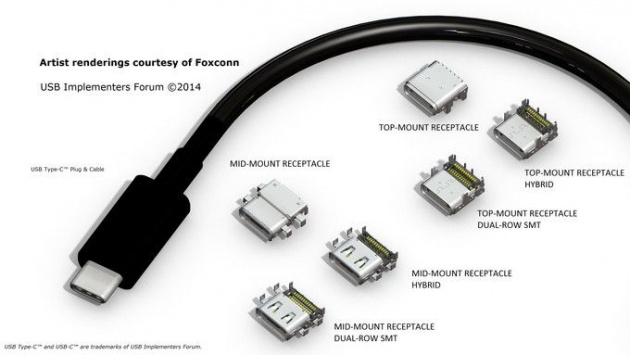
Few are the technology standards as ubiquitous as Universal Serial Bus, commonly known as USB. For almost two decades, it has been doing a great job at connecting our gadgets with one another, allowing them to transfer data back and forth at fast, and sometimes really fast, speeds. But despite the standard's popularity, the general audience doesn't seem to be entirely familiar with its latest specifications. Well, we're here to rectify that. Here's all you need to know about USB 3.1, USB Type-C, and USB Power Delivery.
USB 3.1 and USB Type-C are not the same thing
We've noticed that the terms USB 3.1 and USB Type-C are sometimes used interchangeably, which leads us to believe that the difference between the two isn't clear enough. Simply put, USB is the industry standard and 3.1 is its revision number. It is a technology, not a physical thing. Type-C, however, is just a new type of connector. It is comprised of a Type-C plug and a Type-C receptacle.
It is important to know that while USB Type-C is designed to carry USB 3.1 signals, a device employing the connector is not necessarily compliant with USB 3.1. The Nokia N1 tablet, for example, is a USB 2.0 device even though it uses the Type-C connector. Same goes for the OnePlus 2 smartphone. At the same time, it is possible for a device to use a USB 3.0 Type-A connector – that sexy blue one you find on modern laptops and desktop computers – and still be USB 3.1-compatible.
So, what's the point? Why are there devices using USB Type-C even though they're not USB 3.1-compatible? The answer is simple – convenience.
USB Type-C is reversible, durable, with a small footprint
|
 |
|
USB Type-C is a reversible connector |
All this plugging in and out will not wear out the connector easily. Type-C is designed to endure through no less than 10,000 insertion/extraction cycles, which puts it on par with today's Micro USB connectors. No less importantly, USB Type-C is made to occupy very little space on a circuit board. This is great news for hardware designers as they'll have more precious room inside the electronic devices they build.
Type-C will dominate among USB connectors
|
|
|
The Type-C port on a Chromebook Pixel |
Some devices are already riding this wave of change. The newest Apple MacBook has a single Type-C port, which is used for charging, data transfer, and video output. Google's newest Chromebook Pixel features two of the ports, both with the same capabilities. Note that neither of the two computers needs a dedicated power connector as their batteries are charged via USB (more on that in a bit).
On the downside, the transition to USB Type-C will render the tons of existing USB cables useless as they're physically incompatible with the new connector. You can't insert a Type-A or a Micro USB plug into a Type-C receptacle. But embracing the future is better than resisting it, and we imagine a future where the superior Type-C connector dominates USB-enabled devices.
Speaking of the new connector, here are some of the USB Type-C cables that have already been announced by accessory manufacturer Belkin.
USB 3.1 is faster. Much faster
We've already covered USB Type-C in detail, and now it is time to focus on USB 3.1. But first, a bit of history. The standard's first commercial specification had a maximum data rate of 12 megabits per second, which was enough for users' needs at the time. But eventually, as peripherals' demand for bandwidth grew, the speed limit of USB 1.x became a clear bottleneck. USB 2.0 brought a significant increase in data rates by peaking at 480Mbps. USB 3.0 bumped the speed limit to 5 gigabits per second, and now, USB 3.1 boasts a 10Gbps maximum data rate. Real-life technical demonstrations have shown USB 3.1 reaching 7.2Gbps, which is pretty fast, no matter how you look at it.
As far as smartphones and tablets are concerned, data won't be moving quite as fast, although it won't be transferred slowly either. Let's say that you plug a USB 3.1-compatible smartphone to a USB 3.1-compatible computer. When you start copying files, data will be moving only as fast as the weakest link in the connection can handle it. That would usually be your computer's storage drive or your phone's storage chip. Under ideal conditions, you might be able to get figures in the realm of 150 to 300 megabytes per second, which is only within 30% of what USB 3.1 can handle, but still pretty fast.
|
 |
USB Power Delivery: how do 100 watts sound like?
At the time of its conception, USB was expected to be a vessel for carrying data, not power. That's why USB 1.x and USB 2.0 were capped at a humble 2.5 watts (0.5 amps at 5 volts) – enough to charge a compatible cell phone, but not always sufficient to power something bigger, such as an external hard drive. Then came USB 3.0 and bumped the output to 4.5 watts (0.9 amps at 5 volts). That's a much more acceptable figure, but today's mobile gadgets can easily take at least twice as much juice when charging up their batteries. Thankfully, the USB folks have developed something to address the situation. It is called USB Power Delivery.
USB Power Delivery co-exists with current USB 2.0, 3.0, 3.1, and USB Type-C specifications. It is a different thing, however. USB PD specifies five power delivery profiles – up to 100 watts in scale – applicable over a USB connection while data is being transferred. Technically, there's six of these profiles, but the so-called Profile 0 is "reserved" and doesn't do much at this time. So, here are the five that matter:
- Profile 1 - 5V @ 2A, 10W (Default start-up profile)
- Profile 2 - 12V @ 1.5A, 18W
- Profile 3 - 12V @ 3A, 36W
- Profile 4 - 20V @ 3A, 60W
- Profile 5 - 20V @ 5A, 100W
|
 |
|
Inside a USB PD-compatible Type-C cable. 1 - USB Type-C plug; 2 - identification chip; 3 - shielding; 4 - power conductor |
So, what's in it for mobile devices, then? Well, we're not entirely sure at this point, but it is technically possible to see USB PD-compliant smartphones and tablets in the near future. They'll just be made to work with the profiles of lower power. It is up to their manufacturers to give them support for the USB Power Delivery specification.
But wait! My phone/tablet has a charger that already outputs *insert a large number here* watts of power. Does my device already support USB Power Delivery? No, sorry to disappoint you. As we mentioned above, USB-PD is designed to deliver tons of power over a USB connection while data is moving back and forth. Your charger does provide USB-PD-like amounts of power, but it doesn't transmit data, which has allowed its manufacturer to circumvent the USB specification's limit of 0.5/0.9 amps of current.
A few more things...
There's a couple more things we want you to know about USB Power Delivery. One of them is good, the other – not so much. The good news is that USB PD makes it possible for host and peripheral to switch roles in providing power to the other. In other words, it will be technically possible to charge a tablet from a laptop and vice versa. This feature would also allow smartphones to act as portable power banks for compatible mobile devices.
As for that not-so-good news about USB Power Delivery, it is that the standard requires a so-called Full-Featured USB cable. These cables have a special chip inside them containing information about the cable, including the amount of power it can transmit. The device providing the power reads this data when connected and delivers no more watts than the cable can carry. Full-Featured USB cables are required for sending anything over 1.5 amps or 5 volts. Like it or not, these cables are extremely likely to be more expensive than your garden-variety USB ones. But chances are that USB PD-capable mobile devices would have one in the box.




